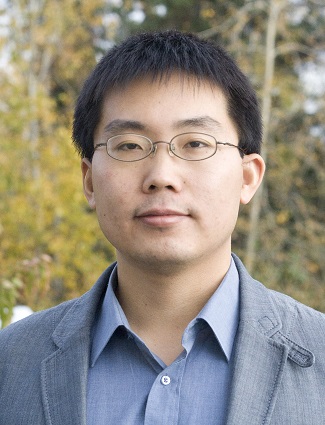Jifeng Peng

Mechanical Engineering
ECB 301H
907-786-6193
jpeng@alaska.edu
https://sites.google.com/site/jfpengweb
Education
Ph.D. Bioengineering (specialty: fluid mechanics) California Institute of Technology,
Pasadena, CA 2009
M.S.Mechanical Engineering, Stony Brook University, Stony Brook, NY 2004
B.S. Mechanical Engineering, University of Science & Technology of China, China, 2002
Teaching Responsibilities
ES A261 Introduction to Engineering Computation
ES A208 Engineering Statics and Dynamics
ES A346 Introduction to Thermodynamics
ME A435 Renewable Energy System Engineering
ME A438 Design of Mechanical Engineering Systems
ME A442/642 Advanced Fluid Mechanics
ME A451/651 Aerodynamics
Professional & Department Service
Reviewer for journals including: Atmospheric Environment, Bioinspiration & Biomimetics, Chaos, Experiments in Fluids, International Journal of Heat and Fluid Flow, International Journal of Non-linear Mechanics, Journal of Experimental Biology, Journal of Fluid Mechanics, Journal of the Japanese Society for Experimental Mechanics, Journal of Physics: Condensed Matter, Marine Technology Society Journal, Physica D: Nonlinear Phenomena, Physics of Fluid, Theoretical and Computational Fluid Dynamics
Research Interests
Computational fluid dynamics (CFD), propulsion, wind and hydro energy, micro-grid, environmental transports, pipeline flows, multiphase flow in porous media, vortex dynamics, marine structures, fluid-structure interactions, oil spills.
Funded Research Projects (a total of $2,221,181 research grants awarded as PI and Co-PI’s portion):
- PI, ‘Arctic ice condition index’, Department of Homeland Security, $195,000, 2019-2020.
- PI, ‘A combustion and dispersion model of particulate matter from in situ oil burning,’ ConocoPhillips, $27,591, 2018-2019.
- Co-PI, ‘Arctic oil spill model’, Department of Homeland Security, Co-PI portion, $100,000, (grant total: $200,000, PI: Texas A&M University), 2018-2019.
- Co-PI, ‘Wind farm in Igiugig Alaska: integration of wind farm into microgrid,’ Gordon and Betty Moore Foundation, Co-PI portion: $1,317,058 (grant total: $1,759,700, PI: Stanford University), 2016-2020.
- Co-PI, ‘Village grid integration strategy,’ Alaska Energy Authority, Co-PI portion: $103,750 (grant total: $421,500, PI: ORPC), 2017-2018.
- PI, ‘Vortex induced vibration in marine pipelines with application to AKLNG,’ ConocoPhillips, $71,299, 2016-2017.
- Co-PI, ‘Arctic coastal erosion forecasting,’ ConocoPhillips, Co-PI portion: $16,331 (grant total: $141,511), 2016 ~2017.
- Co-PI, ‘Wind farm in Igiugig Alaska: demonstration of vertical-axis wind turbines,’ Gordon and Betty Moore Foundation, Co-PI portion: $121,686 (grant total: $679,997, PI: Stanford University), 2013-2016.
- PI, ‘BRIGE: Optimal formation of consecutive vortex rings for propulsion systems,’ National Science Foundation CBET-1228121, $174,957, 2012-2015.
- PI, ‘Feasibility study of vertical-axis wind turbine farm in rural communities in Alaska’s wild salmon systems,’ Gordon and Betty Moore Foundation, $47,991, 2012-2013.
- PI, ‘Ocean plankton distribution patterns in the Alaska region from a coupled population dynamics-physical mixing model,’ Alaska EPSCoR, $19,950, 2012.
- PI, ‘A novel method to predict hazard zones of airborne volcanic ash from eruptions,’ Alaska Space Grant Program, $25,568, 2011-2012.
Publications
Selected Publications:
- Peng J. (2018) “Effects of aerodynamic interactions of closely-placed vertical axis wind turbine pairs,” Energies, 11:2842.
- Cenek M, Haro R, Sayers B, Peng J. (2018) “Power load prediction for rural electrical microgrids using long short term memory and artificial neural networks,” Applied Science, 8:749.
- Peng J, (2015) “Simulation of vortex ring formation and the effect of piston velocity program on the formation number,” Journal of Vortex Science and Technology,2:120.
- Dabiri J, GreerJ, Koseff J, Moin P, Peng J, (2015) “A New Approach To Wind Energy,” AIP Proceeding: Physics of Sustainable Energy, 1652:51.
- Peng J, Webley P, (2015) “Attracting Structures in Volcanic Ash Transport and the Correlation to Environmental Hazard Zones”, book chapter in “Volcanic Ash,” Nova Science Publishers.
- Alben S, Miller LA, Peng J (2013) “Efficient kinematics for jet-propelled swimming,” Journal of Fluid Mechanics, 733:100-133.
- Satti JR, Peng J (2013) “Leapfrogging of two thick-cored vortex rings,” Fluid Dynamics Research, 45: 035503.
- Chen G, Peng J (2012) “An Experimental Investigation of Mode Shift of Cantilever Flexible Plate Coupled with Fluid,” Nonlinear Engineering, 1:59-66.
- Peng J, Chen G (2012) “Flow-Oscillating Structure Interactions and the Applications to Propulsion and Energy Harvest,” Applied Physics Research, 4: 1-14.
- Peng J, Alben S (2012) “Effects of shape and stroke parameters on the performance of an axisymmetric swimmer,” Bioinspiration & Biomimetics, 7: 016012.
- Peng J, Peterson R (2012) “Attracting structures in volcanic ash transport,” Atmospheric Environment, 48: 230-239.
- Sapsis T, Peng J, Haller H (2011) “Instabilities on prey dynamics in jellyfish feeding,” Bulletin of Mathematical Biology 73: 1841-1856.
- Peng J, Dabiri JO (2009) “Transport of inertial particles by Lagrangian Coherent Structures: application to predator-prey interaction in jellyfish feeding,” Journal of Fluid Mechanics 623: 75-84.
- Wilson M, Peng J, Dabiri JO, Eldredge JD (2009) “Lagrangian coherent structures in low Reynolds number swimming,” Journal of Physics: Condensed Matter 21: 204105.
- Peng J, Dabiri JO (2008) “The 'upstream wake' of swimming and flying animals and its correlation with propulsive efficiency,” Journal of Experimental Biology 211: 2669-2677.
- Peng J, Dabiri JO (2008) “An overview of a Lagrangian method for analysis of animal wake dynamics,” Journal of Experimental Biology 211: 280-287.
- Franco E, Pekarek DN, Peng J, Dabiri JO (2007) “Geometry of unsteady fluid transport during fluid-structure interactions,” Journal of Fluid Mechanics 589: 125-145.
- Peng J, Dabiri JO (2007) “A potential-flow, deformable-body model for fluid-structure interactions with compact vorticity: application to animal swimming measurements,” Experiments in Fluids 43: 655-664.
- Peng J, Dabiri JO, Madden PG, Lauder GV (2007) “Non-invasive measurement of instantaneous forces during aquatic locomotion: A case study of the bluegill sunfish pectoral fin,” Journal of Experimental Biology 210: 685-698.
Career History/Work Experience
Professor of Mechanical Engineering, University of Alaska (2020 - present)
Associate Professor of Mechanical Engineering, University of Alaska (2016 - 2020)
Assistant Professor of Mechanical Engineering, University of Alaska (2009 - 2016)









